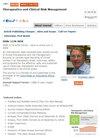Thromboelastography in Long-Term Antiplatelet Therapy for Patients Diagnosed with Benign Prostate Hyperplasia Undergoing Holmium Laser Enucleation of the Prostate: A Retrospective Study
IF 2.8
3区 医学
Q1 Pharmacology, Toxicology and Pharmaceutics
引用次数: 0
Abstract
Objective: To compare low- vs high-power HoLEP effects on coagulation in patients on antiplatelet (AP) therapy via thromboelastography (TEG).Methods: 210 patients was retrospectively analyzed and stratificated into three discrete groups, specifically: Group A (AP therapy, high-power HoLEP, n = 72); Group B (AP therapy, low-power HoLEP, n=73); Group C (no AP therapy, low-power HoLEP, n = 65). Baseline characteristics and coagulation profiles via TEG were compared. Univariate and multivariate analyses were conducted to identify independent risk factors associated with hematuria. Furthermore, parameters such as IPSS, Qmax, post-void residual volume V2 and PSA levels were recorded during 1year follow-up.
Results: No differences in terms of baseline characteristics across all groups. Significant differences were observed in the duration of enucleation, morcellation, bladder irrigation, post-operative catheterization, length of hospital stay and the extent of hemoglobin reduction (F = 54.06, 8.54, 6.68, 9.24, 17.06, 5.97, p < 0.05). No differences were noted in postoperative hematuria, urine retention, transfusion rates, and SUI (x12 = 1.082 ; x22 = 0.197,; x32 = 3.981;x42 = 0.816, p > 0.05). Univariate and multivariate analyses revealed that prostate volume emerged as an independent risk factor for hematuria (OR 1.080, 95% CI: 1.007– 1.158, p = 0.031). Clinical outcomes including Qmax, IPSS, V2, and PSA demonstrated significant enhancement during 1 year follow-up.
Conclusion: Compared to HP-HoLEP, LP-HoLEP effectively reduces surgical and subsequent processing times, decreases hospital stay duration, and diminishes hemoglobin decline, offering a viable option without discontinuing AP therapy.
Keywords: anti-platelet therapy, BPH, high power, HoLEP, low power
接受前列腺钬激光去核术的良性前列腺增生患者在长期抗血小板治疗中的血栓弹性成像:一项回顾性研究
目的通过血栓弹性成像(TEG)比较低功率和高功率 HoLEP 对抗血小板(AP)治疗患者凝血功能的影响:A组(AP疗法,高功率HoLEP,n=72);B组(AP疗法,低功率HoLEP,n=73);C组(无AP疗法,低功率HoLEP,n=65)。通过 TEG 对基线特征和凝血情况进行了比较。进行了单变量和多变量分析,以确定与血尿相关的独立风险因素。此外,还记录了随访一年期间的 IPSS、Qmax、排尿后残余尿量 V2 和 PSA 水平等参数:各组的基线特征无差异。在去核、切除、膀胱冲洗、术后导尿、住院时间和血红蛋白降低程度方面观察到显著差异(F = 54.06、8.54、6.68、9.24、17.06、5.97,P < 0.05)。术后血尿、尿潴留、输血率和 SUI 无差异(x12 = 1.082; x22 = 0.197,; x32 = 3.981;x42 = 0.816, p >0.05)。单变量和多变量分析显示,前列腺体积是血尿的独立危险因素(OR 1.080,95% CI:1.007- 1.158,P = 0.031)。包括Qmax、IPSS、V2和PSA在内的临床结果在1年的随访中均有显著改善:与 HP-HoLEP 相比,LP-HoLEP 可有效缩短手术时间和后续处理时间,缩短住院时间,减少血红蛋白下降,在不中断 AP 治疗的情况下提供了一种可行的选择。 关键词:抗血小板治疗;良性前列腺增生;高功率;HoLEP;低功率
本文章由计算机程序翻译,如有差异,请以英文原文为准。
求助全文
约1分钟内获得全文
求助全文
来源期刊

Therapeutics and Clinical Risk Management
HEALTH CARE SCIENCES & SERVICES-
CiteScore
5.30
自引率
3.60%
发文量
139
审稿时长
16 weeks
期刊介绍:
Therapeutics and Clinical Risk Management is an international, peer-reviewed journal of clinical therapeutics and risk management, focusing on concise rapid reporting of clinical studies in all therapeutic areas, outcomes, safety, and programs for the effective, safe, and sustained use of medicines, therapeutic and surgical interventions in all clinical areas.
The journal welcomes submissions covering original research, clinical and epidemiological studies, reviews, guidelines, expert opinion and commentary. The journal will consider case reports but only if they make a valuable and original contribution to the literature.
As of 18th March 2019, Therapeutics and Clinical Risk Management will no longer consider meta-analyses for publication.
The journal does not accept study protocols, animal-based or cell line-based studies.
 求助内容:
求助内容: 应助结果提醒方式:
应助结果提醒方式:


